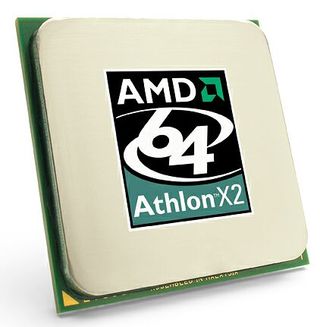From Cards To Chips
In addition to that sexy graphics card, you might also want to consider the AMD Athlon 64 X2 3800+ and Athlon 64 FX-57 processors.

FX-57

X2 3800+
AMD's dual core scores a clear hit in terms of performance, and also power consumption (and thus cool operation). In an earlier review on THG, we recommended the 3800+ - the entry point into the Athlon 64 X2 processor line - as a great buy. It's not significantly more expensive than single core models, but offers terrific performance, especially for multi-threaded applications that can make the best use of its capabilities.
The 3800+ is built around the Manchester core, which uses 1 MB of L2 Cache, 512 kB for each of the two cores. Though this does slow the processor down somewhat by comparison with other models in the X2 processor line with twice as much cache, it also contributes to the lower power consumption and heat dissipation that are so likable about this CPU. The 3800+'s cool operation also makes it a pretty good candidate for overclocking, as our own lab experience confirms.
With a rated speed of 2.0 GHz, the 3800+ is also slower than the other members of the X2 product family as well. But while it may not be as fast as its siblings, it can outperform most conventional Athlon 64 processors without breaking too much of a sweat. Our earlier review makes the point that the 3800+ compares very favorably with the Intel Pentium D 820, except for audio and video decoding, where the Intel processor has a distinct edge. With retail prices starting at around $300, this could be a great gift for somebody with a socket 939 motherboard who could use a performance boost. That's especially so if they run a lot of office productivity apps, where multi-threading makes the X2 really shine.
At the other end of the processor spectrum, in looking at gaming systems, we were reminded that the AMD Athlon 64 FX family offers the most extreme levels of performance, even if it is only a single core processor. In the test machine we built for this buyer's guide, we observed the same temperatures (25° C/77° F) when using the FX-57 as for the 3800+ when the system ran under normal load. When we fired up Doom III and ran both eVGA 7800GT cards (also included in this Buyer's Guide) on a Gigabyte K8N Ultra-SLI motherboard full out, temperatures rose only to a relatively balmy 44° C (a little over 111° F) even though frame rates absolutely screamed.
Stay on the Cutting Edge
Join the experts who read Tom's Hardware for the inside track on enthusiast PC tech news — and have for over 25 years. We'll send breaking news and in-depth reviews of CPUs, GPUs, AI, maker hardware and more straight to your inbox.
At a CPU speed of 2.8 GHz, the FX-57 sits at the absolute apex for all of AMD's processor lines. It's still pretty reasonable about power consumption: our earlier tests showed reference systems consuming 145 watts at idle, and 204 watts at maximum load (as compared to 196/287 for a P4 660, or 214/315 for a Pentium D 840).
Unfortunately, this processor is also at the apex when it comes to price: "rock bottom prices" for the FX-57 run around $950, and they typically cost over $1,000. But for the most serious of gamers, looking for every possible bit of speed and performance, the FX-57 lets you roll some pretty heavy artillery onto the field of play. Maybe Santa could make a special exception in this one case?
Ed Tittel is a long-time IT writer, researcher and consultant, and occasional contributor to Tom’s Hardware. A Windows Insider MVP since 2018, he likes to cover OS-related driver, troubleshooting, and security topics.
Most Popular


